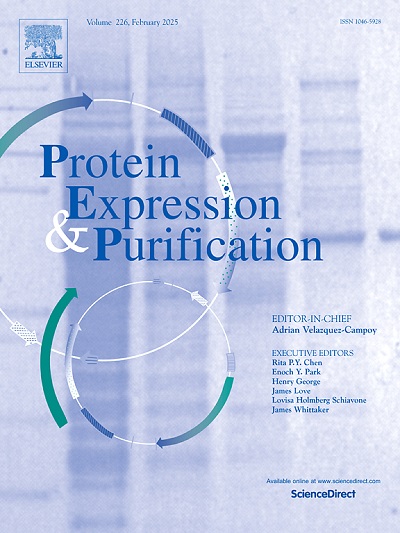Expression and purification of Austropuccinia psidii effector proteins in Escherichia coli
IF 1.2
4区 生物学
Q4 BIOCHEMICAL RESEARCH METHODS
引用次数: 0
Abstract
The plant disease myrtle rust is caused by the fungus Austropuccinia psidii. It has led to functional myrtaceous species extinctions in Australia and is a significant threat to other species globally. During infection, A. psidii secretes effector proteins that manipulate the host plant's defences. Numerous putative effectors are encoded in this pathogen's genome, some being expressed early during urediniospore germination and initial invasion of plant tissues. Four putative effector proteins (AP1260, AP5292, AP10948, and AP143) were found to be differentially expressed in the first 24–48 h of infection, suggesting that they play important roles in the infection process. As in other rust fungi, these effector proteins are small and cysteine-rich, often forming disulfide bonds, and their isolation for biophysical characterisation can be challenging. AlphaFold3 models predict that AP1260, AP5292, AP10948, and AP143 form disulfide bonds, while disorder analysis indicates the presence of intrinsically disordered regions. The four putative A. psidii effector proteins were recombinantly produced using SHuffle Escherichia coli cells with an adapted co-expression vector, ‘ApFunCyDisCo’. Three of the effectors were successfully produced, but were insoluble. The fourth effector, AP1260, was successfully produced in the soluble fraction and purified using a four-step process: immobilised metal affinity chromatography, desalting, anion exchange chromatography, and size exclusion chromatography. Circular dichroism spectroscopy revealed that AP1260 has a mainly random coil character, but also has both β-strand and α-helical content. This first successful production and isolation of an A. psidii protein provides a foundation for future investigation of the molecular mechanisms of A. psidii pathogenicity.
psidii效应蛋白在大肠杆菌中的表达与纯化。
桃金娘锈病是一种由桃金娘锈病真菌引起的植物病害。它已导致澳大利亚功能性桃金娘科物种灭绝,并对全球其他物种构成重大威胁。在感染期间,psidii分泌效应蛋白来操纵宿主植物的防御。在这种病原体的基因组中编码了许多可能的效应物,其中一些在芽孢萌发和植物组织初始入侵的早期表达。4种推测的效应蛋白(AP1260、AP5292、AP10948和AP143)在感染后24-48小时内差异表达,提示它们在感染过程中发挥重要作用。与其他锈菌一样,这些效应蛋白很小且富含半胱氨酸,通常形成二硫键,分离它们进行生物物理表征可能具有挑战性。AlphaFold3模型预测AP1260、AP5292、AP10948和AP143形成二硫键,而无序分析表明存在内在无序区域。利用重组大肠杆菌细胞和适应性共表达载体“ApFunCyDisCo”重组产生了四种推测的psidii效应蛋白。成功制备了三种效应器,但不溶性。第四种效应器AP1260成功地从可溶性部分中产生,并通过四步工艺纯化:固定化金属亲和层析、脱盐、阴离子交换层析和尺寸排除层析。圆二色光谱分析表明,AP1260主要具有无规螺旋结构,但同时含有β-链和α-螺旋结构。这一首次成功的psidii蛋白的制备和分离为psidii致病性分子机制的进一步研究奠定了基础。
本文章由计算机程序翻译,如有差异,请以英文原文为准。
求助全文
约1分钟内获得全文
求助全文
来源期刊

Protein expression and purification
生物-生化研究方法
CiteScore
3.70
自引率
6.20%
发文量
120
审稿时长
32 days
期刊介绍:
Protein Expression and Purification is an international journal providing a forum for the dissemination of new information on protein expression, extraction, purification, characterization, and/or applications using conventional biochemical and/or modern molecular biological approaches and methods, which are of broad interest to the field. The journal does not typically publish repetitive examples of protein expression and purification involving standard, well-established, methods. However, exceptions might include studies on important and/or difficult to express and/or purify proteins and/or studies that include extensive protein characterization, which provide new, previously unpublished information.
 求助内容:
求助内容: 应助结果提醒方式:
应助结果提醒方式:


